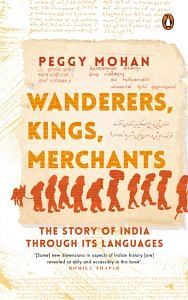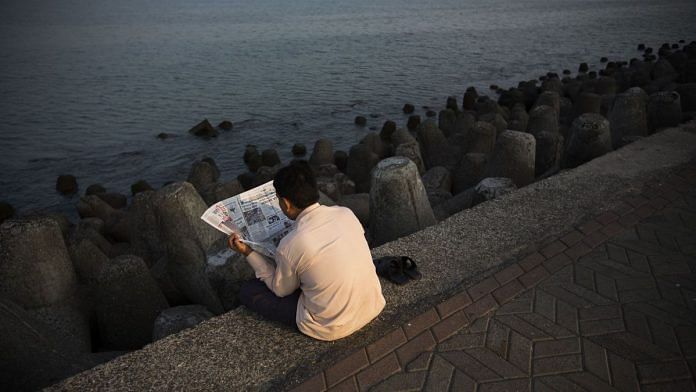Throughout the British Raj, Indian English continued to be a second language for educated Indian men in government service, men who still had their Indian languages for family life and the literature and poetry they read for pleasure, while keeping their English as a code for the workplace. Despite this division of labour between the languages, the situation was pretty much one of bilingualism, in the sense that the Indian bābus did know their first languages very well, and preferred to speak them instead of English whenever possible, even with Indian colleagues at work. They always sounded stiff and uncomfortable in English. Macaulay’s English-medium education was not designed to kick in until Indian boys had been through primary school in their mother tongue, and their first language was firmly in place as a language of refuge.
Meanwhile in India, the movement for swarāj, or ‘independence’, was gaining ground, and this was the big chance to shake off the oppressive linguistic burden the British had imposed. India could go back to an administrative structure based on Persian, as in Mughal times. Or it could go forward into a new egalitarian age based on socialist principles, where rich and poor alike spoke the same language, and the children of the rich and the poor sat side by side in class in neighbourhood schools where there were no fees, learning their lessons in Indian languages. English could be banished with the stroke of a pen!
There was much enthusiasm for this in the Constituent Assembly Debates held by the Interim Government of India between December 1946 and January 1950. Gandhi-ji was one of the strongest in his opposition to English-medium education. In one of his articles in Young India, written as early as 1919, he said: ‘The existing system of education is defective, apart from its association with an utterly unjust government in three most important matters: i) It is based upon foreign culture to the almost entire exclusion of indigenous culture; ii) It ignores the culture of heart and the hand and confines itself simply to the head, and iii) Real education is impossible through a foreign medium.’
But, in the end, as we know, things turned out differently.
Also read: The real crisis in Indian literature is the translation pyramid. Bangla sits at the top
As the Constituent Assembly Debates went on, there were different groups interested in keeping English in independent India. Bhimrao Ramji Ambedkar, the architect of the Indian Constitution, supported English as being best for the Dalit community he represented, as he felt that it was equidistant from all the communities of India, and thus would remove the advantage Brahmins would have if Sanskritized Hindi were made the national language. There was also great concern in south India at the thought of Hindi, a language of the North, becoming the national language.
Maulana Hasrat Mohani, the originator of the slogan inqilāb zindābād, ‘long live the revolution’, sensed the pressure building for a compromise on the English question, and in an anguished intervention in a Constituent Assembly Debate later in September 1949, protested against English-medium education not simply continuing in independent India, but being extended to primary schooling as well, since the elite wanted this for their own children.
Independent India chose to keep and extend its large sector of elite private schools, which were English medium, instead of going the socialist route like most other countries—including the USA—which had neighbourhood schools, where rich and poor children sat in mixed classes studying at government expense in the local language. But this was not a continuation of the English-medium system started in Macaulay’s schools, the missionary schools, the convent schools and the elite boarding schools. Macaulay had been perfectly happy with Indian children getting their primary education in the home language, and only making the switch to English medium (if they wished) at middle school. English medium became de rigueur only in high school and at university. What changed around the time of Independence is that many Indian private schools opened primary sections, and these too were designed to teach in English medium. For the first time in India, elite children as young as age five, or even younger, would be getting all their schooling in English.
Private schools in India are unusual in that they tend to be single institutions, where students enter at the age of three and leave only at the end of secondary school. In most countries, primary schools are separate institutions from secondary schools, and for a child moving on to secondary school means a fresh admission procedure. This makes it easy for a government to have different policies for the two levels, allowing it to focus on the primary sector first, universalizing primary education, and only then turning its attention to its secondary schools. At secondary school the sense of a fresh start with new classmates and new surroundings can smoothen the transition to a new language medium, if that is what the society desires, once children have their fundamentals in place because of early schooling in a language they truly understand. If India had kept primary education separate from secondary, and kept it in the home language, that would have been a continuation of Macaulay’s vision.
Also read: Stop this kolaveri against English-speaking Indians. They didn’t ruin idea of India
But instead it was back to old times: the elite wanted a language that set them apart from ordinary people. So English segued smoothly from being the language of the erstwhile colonial masters to being the code that identified the new masters. The crème de la crème would be the children who spoke English at home as well as in school, while the children of the aspirational classes would enter these Towers of Babel with no knowledge of English, charged with the mind- numbing task of sitting in incomprehension day after day in order to lead their families over the high mountain pass into the Promised Land. The poor were to stay put obediently on the sidelines, with access only to poorly funded state-government schools that taught in Indian languages—that is, if they were lucky enough to get any schooling at all.
Ironically, then, Independence was the great watershed moment for Indian English. Up until then, English had been just a second language for a few Indians: the only people who knew it natively were the British and the Anglo-Indians, and they were now out of power. But with Indian children who were still picking up their first language poised to get their primary schooling in English medium, English started to grow from a mere second language that ‘knew its place’ to become an adjunct first language for the most empowered section of the Indian population.
One big difference between the bilingualism that existed during the British Raj and our present diglossia20 is that English now enters the picture before children have finished setting down their first language, making the boundary between their first language and English porous. What we end up with is not two languages which duplicate each other, or bilingualism, but a single competence that spans two (or more) languages, with the first language optimized for things to do with childhood, or interaction with the poor, and the second language with a less limited role. It is like the relationship between a local tree stump and the exotic graft strapped on to it, which will yield more marketable fruit and flowers.
 This excerpt from ‘Wanderers, Kings, Merchants: The Story of India Through Its Languages’ by Peggy Mohan has been published with permission from Penguin Random House India.
This excerpt from ‘Wanderers, Kings, Merchants: The Story of India Through Its Languages’ by Peggy Mohan has been published with permission from Penguin Random House India.



